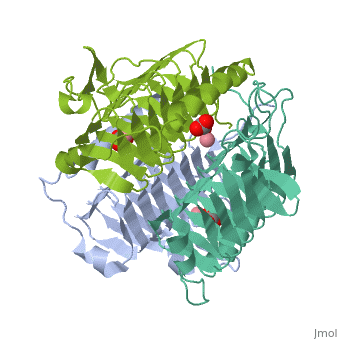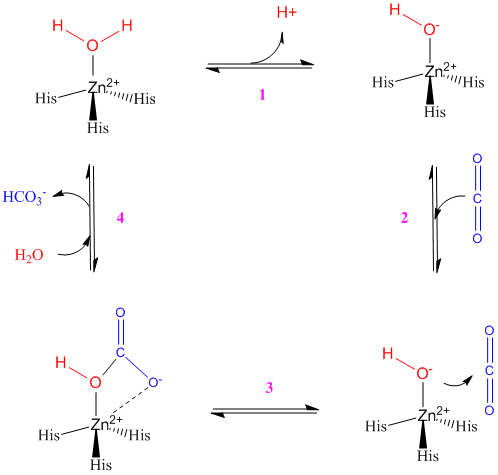Gamma Carbonic Anhydrase
From Proteopedia
(New page: ='''Gamma Carbonic Anhydrase'''= {{STRUCTURE_1qre | PDB=1qre | SCENE= }} ==Introduction/Background== Gamma carbonic anhydrase is an enzyme that is produced by the methanoarchaeon [http://...) |
|||
| (2 intermediate revisions not shown.) | |||
| Line 1: | Line 1: | ||
| + | <StructureSection load='1qre' size='400' side='right' scene='' caption='γ-carbonic anhydrase from ''Methanosarcina thermophila'' complex with bicarbonate ion and Co (II) , [[1qre]]'> | ||
='''Gamma Carbonic Anhydrase'''= | ='''Gamma Carbonic Anhydrase'''= | ||
| - | + | ||
==Introduction/Background== | ==Introduction/Background== | ||
| Line 15: | Line 16: | ||
According to the [http://en.wikipedia.org/wiki/Structural_Classification_of_Proteins Structural Classification of Proteins] (SCOP), γ-carbonic anhydrase is part of the [http://supfam.org/SUPERFAMILY/cgi-bin/scop.cgi?sunid=51161 Trimeric LpxA Enzyme superfamily], which is characterized by single-stranded polypeptides with left-handed beta-helix fold. The overall structure of γ-carbonic anhydrase is a trimer complex composed of left-handed <scene name='Sandbox_176/Beta-helix/1'>beta-helix monomers</scene>. The beta-helix consists of three untwisted, parallel sheets that are connected by left-handed crossovers <ref name="pdb" />. Like all the carbonic anhydrase proteins, γ-carbonic anhydrase contains a metal ion ligand in its active site. The unique feature of γ-carbonic anhydrase is its ability to utilize two metal ions equivalently for its active site, the zinc ion, Zn<sup>2+</sup> and the cobalt ion, Co<sup>2+</sup>. Studies have shown that the enzyme is able to use these two ions interchangeable depending on their availability <ref name="gamma" />. While studies indicate that there are no significant differences between zinc-bound and cobalt-bound γ-carbonic anhydrase structures, the catalytic mechanism for binding of carbon dioxide is different between the three classes of carbonic anhydrases. In both zinc-bound and cobalt-bound γ-carbonic anhydrases there are three histidine residues (His81, His117 and His122 residues) that coordinate the ion with the <scene name='Sandbox_176/Ligan/1'>active site</scene> <ref name="pdb" />. In addition to the three histidines, there are several other residues which have been identified to play an important role in the active site catalytic mechanism. For example the glutamine residue Gln75 and the asparagine residue Asn73 have been found to help orient the cobalt ion for attack on the carbon dioxide, and the asparagine residue Asn202 prepares the carbon dioxide, by polarization, for attack by the cobalt ion <ref name="hbond">PMID:16618104</ref>. | According to the [http://en.wikipedia.org/wiki/Structural_Classification_of_Proteins Structural Classification of Proteins] (SCOP), γ-carbonic anhydrase is part of the [http://supfam.org/SUPERFAMILY/cgi-bin/scop.cgi?sunid=51161 Trimeric LpxA Enzyme superfamily], which is characterized by single-stranded polypeptides with left-handed beta-helix fold. The overall structure of γ-carbonic anhydrase is a trimer complex composed of left-handed <scene name='Sandbox_176/Beta-helix/1'>beta-helix monomers</scene>. The beta-helix consists of three untwisted, parallel sheets that are connected by left-handed crossovers <ref name="pdb" />. Like all the carbonic anhydrase proteins, γ-carbonic anhydrase contains a metal ion ligand in its active site. The unique feature of γ-carbonic anhydrase is its ability to utilize two metal ions equivalently for its active site, the zinc ion, Zn<sup>2+</sup> and the cobalt ion, Co<sup>2+</sup>. Studies have shown that the enzyme is able to use these two ions interchangeable depending on their availability <ref name="gamma" />. While studies indicate that there are no significant differences between zinc-bound and cobalt-bound γ-carbonic anhydrase structures, the catalytic mechanism for binding of carbon dioxide is different between the three classes of carbonic anhydrases. In both zinc-bound and cobalt-bound γ-carbonic anhydrases there are three histidine residues (His81, His117 and His122 residues) that coordinate the ion with the <scene name='Sandbox_176/Ligan/1'>active site</scene> <ref name="pdb" />. In addition to the three histidines, there are several other residues which have been identified to play an important role in the active site catalytic mechanism. For example the glutamine residue Gln75 and the asparagine residue Asn73 have been found to help orient the cobalt ion for attack on the carbon dioxide, and the asparagine residue Asn202 prepares the carbon dioxide, by polarization, for attack by the cobalt ion <ref name="hbond">PMID:16618104</ref>. | ||
| - | + | </StructureSection> | |
==Catalytic Mechanism== | ==Catalytic Mechanism== | ||
| Line 25: | Line 26: | ||
| + | ==3D structues of γ-carbonic anhydrase== | ||
| + | [[Carbonic anhydrase]] | ||
==References== | ==References== | ||
<references/> | <references/> | ||
Current revision
| |||||||||||
Catalytic Mechanism
The catalytic mechanism for γ-carbonic anhydrase active site is shown below, using zinc as the metal ion ligand. In the case of cobalt as the metal ion ligand, there is an additional water molecule present in the active site. In the first step the zinc ion is coordinated with two water molecules (only one is shown on the diagram) and the three histidine residues. The Glu62 residue donates electrons to one of the water molecules, which in turn donates the electrons to the neighbouring water molecule (this is shown by the hydrogen ion on the diagram).The result is a zinc hydroxide. In the next step (2 to 3) the zinc hydroxide attacks the incoming carbon dioxide molecule, which is held in place in the proper orientation by Asn202 and Gln75 residues (not shown), to form the bicarbonate ion and displace one of the water molecules. In the final steps (3 to 4), the bicarbonate ion is displaced through hydrogen bonding with the Glu62 residue and the addition of two water molecules to the zinc ion. The water molecules replace the two oxygen molecules that were bound to the zinc ion, thus regenerating the enzyme [1] [4].
3D structues of γ-carbonic anhydrase
References
- ↑ 1.0 1.1 1.2 1.3 1.4 1.5 Iverson TM, Alber BE, Kisker C, Ferry JG, Rees DC. A closer look at the active site of gamma-class carbonic anhydrases: high-resolution crystallographic studies of the carbonic anhydrase from Methanosarcina thermophila. Biochemistry. 2000 Aug 8;39(31):9222-31. PMID:10924115
- ↑ 2.0 2.1 Alber BE, Colangelo CM, Dong J, Stalhandske CM, Baird TT, Tu C, Fierke CA, Silverman DN, Scott RA, Ferry JG. Kinetic and spectroscopic characterization of the gamma-carbonic anhydrase from the methanoarchaeon Methanosarcina thermophila. Biochemistry. 1999 Oct 5;38(40):13119-28. PMID:10529183
- ↑ 3.0 3.1 3.2 Alber BE, Ferry JG. A carbonic anhydrase from the archaeon Methanosarcina thermophila. Proc Natl Acad Sci U S A. 1994 Jul 19;91(15):6909-13. PMID:8041719
- ↑ 4.0 4.1 Zimmerman SA, Ferry JG. Proposal for a hydrogen bond network in the active site of the prototypic gamma-class carbonic anhydrase. Biochemistry. 2006 Apr 25;45(16):5149-57. PMID:16618104 doi:10.1021/bi052507y


